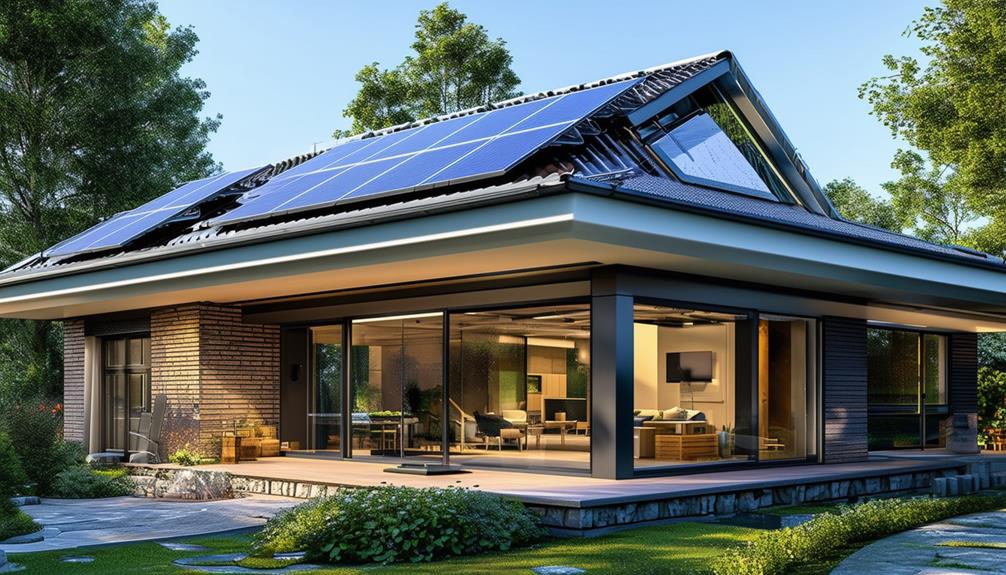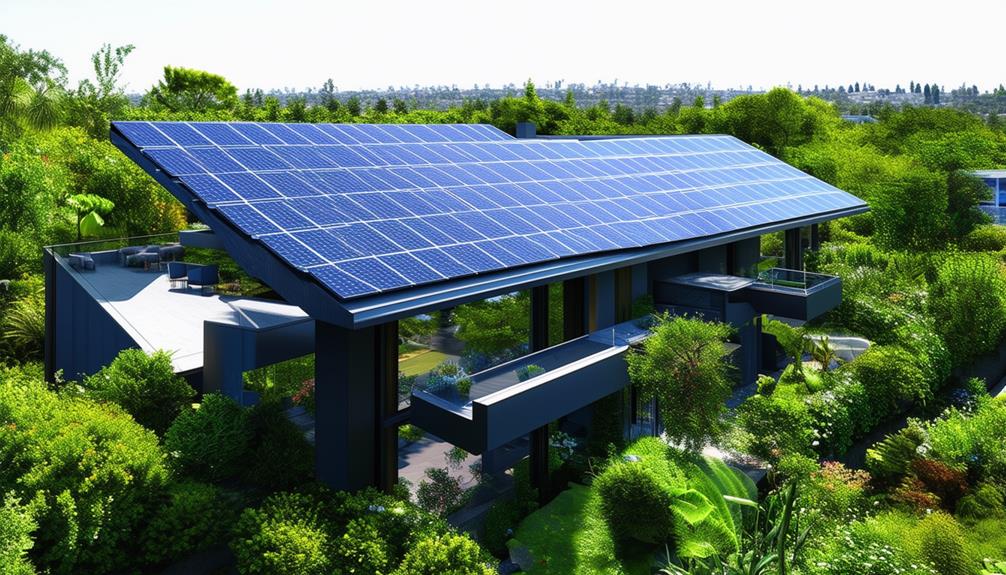Smart Roofing Systems are the cutting-edge of roofing technology, offering energy efficiency and durability far beyond traditional roofs. Integrating IoT enhances proactive leak detection and real-time monitoring, increasing efficiency. By incorporating solar panels and eco-friendly materials, like cool roofs, smart roofs prioritize sustainability. Drones improve safety and speed of inspections, while sustainable materials reduce environmental impact. Safety is enhanced through remote monitoring and automated alerts. Embrace the future of roofing with advanced technologies and sustainable practices for longevity and efficiency.
Advantages of Smart Roofing Systems

Smart roofing systems offer numerous benefits to homeowners, including improved energy efficiency and enhanced durability. These systems provide significant cost savings over time due to their ability to regulate indoor temperatures effectively. By leveraging smart technology, these roofs can adjust ventilation and insulation settings based on external weather conditions, resulting in reduced energy consumption and lower utility bills. The environmental benefits are also substantial, as smart roofing systems help decrease overall carbon emissions by optimizing energy usage.
Moreover, the longevity of smart roofing systems surpasses that of traditional roofs. The incorporation of advanced materials and smart sensors guarantees early detection of potential issues, preventing extensive damage and increasing the lifespan of the roof. With the ability to self-monitor and alert homeowners of maintenance requirements, these roofs are at the forefront of building innovation. Fundamentally, investing in a smart roofing system not only enhances your home's efficiency and durability but also contributes to a sustainable future.
Integration of IoT in Roofing
Imagine a roofing system that can proactively detect leaks or damage through IoT sensors, enabling efficient maintenance before issues escalate. With IoT integration, your roof becomes a smart system that collects real-time data, allowing for predictive maintenance schedules and cost-effective repairs. Embracing IoT in roofing not only enhances efficiency but also revolutionizes the way maintenance is approached, shifting towards a proactive and data-driven strategy.
IoT for Efficiency
Integrating Internet of Things (IoT) technology into roofing systems enhances efficiency by enabling real-time monitoring and data-driven decision-making. By incorporating IoT monitoring sensors into roofing materials, you can track environmental factors like temperature, humidity, and sunlight exposure. These sensors provide valuable data that can be analyzed to optimize energy usage and increase energy savings.
IoT-enabled roofing systems can automatically adjust ventilation and insulation levels based on real-time data, ensuring peak energy efficiency year-round. For instance, during hot summer months, the sensors can trigger cooling mechanisms to reduce the need for air conditioning, leading to significant energy savings. In colder seasons, the system can adjust insulation to retain heat and minimize heating costs.
Furthermore, IoT technology allows for proactive maintenance by detecting potential issues early on. By monitoring the roof's condition continuously, any signs of damage or wear can be swiftly identified and addressed, preventing costly repairs down the line. Implementing IoT for efficiency in roofing not only reduces energy consumption but also enhances the overall performance and longevity of the roof.
Data-Driven Maintenance
Enhancing the efficiency of roofing systems through the integration of IoT technology involves leveraging data-driven maintenance practices to guarantee peak performance and longevity. Predictive analytics plays a pivotal role in this approach by analyzing historical data to predict when maintenance is required, preventing potential issues before they escalate. By implementing remote monitoring through IoT sensors embedded in the roofing system, real-time data on temperature, moisture levels, and structural integrity can be collected and analyzed.
Remote monitoring allows for proactive maintenance scheduling based on actual performance data rather than fixed timelines, optimizing resource allocation and reducing downtime. Predictive analytics combined with remote monitoring enables roofing professionals to address issues promptly, extending the lifespan of the roof and minimizing repair costs. Additionally, data-driven maintenance facilitates informed decision-making by providing insights into trends and performance patterns, allowing for continuous improvement in roofing system management. Embracing data-driven maintenance practices through IoT integration is key to ensuring the reliability and longevity of roofing systems in the ever-evolving construction industry.
Energy Efficiency in Roofing Technology

In the field of roofing technology, advancements in energy efficiency have revolutionized the way buildings mitigate heat gain and loss through their roofs. Solar integration and eco-friendly materials play a vital role in enhancing energy efficiency. By incorporating solar panels into roofing systems, buildings can harness renewable energy sources to reduce reliance on traditional power grids, leading to significant energy savings. Eco-friendly materials such as cool roofs, which reflect sunlight and absorb less heat, contribute to reducing cooling costs and minimizing the urban heat island effect.
Green technology in roofing extends beyond materials, encompassing innovative design strategies that optimize energy efficiency. Features like green roofs, which support vegetation growth, provide natural insulation and reduce the energy needed for heating and cooling. Additionally, advanced insulation materials and ventilation systems further enhance the energy efficiency of roofing systems.
Impact of Drones on Roof Inspection
You can harness the efficiency of drones for roof inspections, revolutionizing the way assessments are conducted. Through aerial surveys, drones offer a bird's eye view of your roof, enabling detailed assessments without the need for manual labor. The advantages of using drones in roof inspections include improved safety, faster data collection, and enhanced accuracy in identifying potential issues.
Drone Efficiency in Inspection
Utilizing drones for roof inspections revolutionizes the efficiency and accuracy of the assessment process, greatly enhancing the overall quality of data collection. Drones offer unparalleled advantages concerning drone accuracy and cost-effectiveness. The ability to capture high-resolution images and videos allows for a detailed analysis of the roof's condition, detecting even the smallest of issues that might be missed during a traditional inspection.
- Drone Accuracy: Drones provide precise measurements and detailed images, ensuring that no area of the roof is left uninspected.
- Cost Effectiveness: Drones reduce the need for manual labor and equipment, making inspections more affordable without compromising quality.
- Remote Monitoring and Real-time Analysis: With drones, inspectors can monitor the roof inspection remotely and analyze the data in real-time, enabling quicker decision-making and immediate identification of potential problems.
Incorporating drones into the roof inspection process not only saves time and resources but also enhances the accuracy and thoroughness of the assessment, ultimately leading to better maintenance and longevity of roofs.
Advantages of Aerial Surveys
Aerial surveys conducted through drone technology revolutionize the efficiency and accuracy of roof inspections, presenting significant advantages in data collection for evaluating roof conditions. Drones offer cost savings by reducing the need for manual labor and equipment traditionally required for roof inspections. With drones, the overall cost of inspections decreases due to fewer resources being used, resulting in more affordable services for customers.
Moreover, drones enhance time efficiency by swiftly capturing detailed aerial footage of roofs. This quick data collection process allows for expedited roof assessments and faster decision-making regarding maintenance or repairs. By utilizing drones for aerial surveys, roofing companies can complete inspections in a fraction of the time it would take using conventional methods, enabling them to serve more clients efficiently.
Sustainable Materials for Smart Roofs

Incorporating sustainable materials in smart roofing systems is essential for enhancing environmental performance and longevity. When choosing materials for your smart roof, consider the following green alternatives and eco-friendly options:
- Recycled Content: Utilizing materials with recycled content like recycled metal or shingles made from recycled plastics can greatly reduce the environmental impact of your roof. These materials not only help divert waste from landfills but also require less energy to produce compared to virgin materials.
- Cool Roof Coatings: Opting for cool roof coatings can improve energy efficiency by reflecting more sunlight and absorbing less heat. These coatings are typically made from reflective materials like acrylics or silicones, reducing the urban heat island effect and lowering cooling costs.
- Sustainable Wood: If you prefer a more traditional look, consider sustainable wood options like cedar or redwood sourced from responsibly managed forests. These wood types are durable, renewable, and can add a touch of natural beauty to your smart roof.
Enhancing Safety With Smart Roofing Technologies
To further enhance the environmental sustainability of your smart roofing system, consider integrating cutting-edge technologies that prioritize safety and efficiency. Safety enhancements are vital in the roofing industry, and smart roofing technologies offer innovative solutions to guarantee the well-being of workers and occupants. One key safety feature is remote monitoring, which allows real-time tracking of the roof's condition without the need for physical inspection. By implementing remote monitoring systems, you can detect potential issues early on, preventing accidents and minimizing repair costs.
In addition to remote monitoring, smart roofing technologies also offer features such as automated safety alerts and sensors that can detect changes in temperature, moisture levels, or structural integrity. These advancements provide proactive safety measures, giving you peace of mind knowing that your roof is continuously monitored for any potential risks. By embracing these safety enhancements, you not only protect the individuals working on or around the roof but also extend the lifespan of your roofing system through early detection and preventive maintenance strategies.
Frequently Asked Questions
Can Smart Roofing Systems Be Easily Integrated With Existing Roofs?
Integrating smart roofing systems with existing roofs can be a smooth process. The key lies in guaranteeing compatibility between the IoT technology of the smart system and the current roofing structure. By carefully evaluating the roofing integration requirements and planning for longevity with regards to technological advancements, you can successfully incorporate smart features into your roof without compromising its integrity. This approach guarantees a seamless shift to a more efficient and innovative roofing solution.
What Is the Lifespan of Iot Components in Smart Roofs?
When considering IoT component longevity, integration challenges may arise. The lifespan of these components can vary based on factors like maintenance, environmental conditions, and technological advancements. Ensuring compatibility with existing infrastructure is important for maximizing their lifespan. Regular maintenance and updates are necessary to mitigate any potential risks and maintain peak performance. By staying informed about the latest technologies and practices, you can overcome integration challenges and extend the lifespan of IoT components in smart roofs.
Do Energy-Efficient Roofing Technologies Qualify for Tax Incentives?
To begin with, energy-efficient roofing technologies can indeed qualify for tax incentives through various programs. These incentives are typically provided to encourage the adoption of environmentally friendly practices, such as installing energy-saving roofing systems. By leveraging these tax benefits, you can not only contribute to a more sustainable future but also save on energy costs in the long run. Be sure to explore the options available in your area to maximize your savings potential.
Are There Regulations for Using Drones in Roof Inspections?
When it comes to using drones in roof inspections, it's essential to adhere to drone regulations and implement stringent safety measures. These regulations often include guidelines on flight altitude, proximity to buildings, and pilot certification. Safety measures involve pre-flight checks, obstacle avoidance, and emergency procedures. By following these rules diligently, you can guarantee efficient and secure drone-assisted roof inspections while complying with legal requirements and minimizing risks.
How Do Sustainable Materials in Smart Roofs Impact the Environment?
When considering sustainable materials in smart roofs, the environmental impact is significant. By utilizing sustainable materials, smart roofs contribute to reducing waste and promoting eco-friendly practices. These materials enhance energy efficiency, resulting in decreased energy consumption and lowering carbon footprints. Regulations often govern the use of sustainable materials to guarantee they meet environmental standards, promoting a greener approach to roofing that benefits both the environment and building occupants.
Conclusion
To sum up, smart roofing systems are revolutionizing the way we think about roofing technology. With the integration of IoT, drones for inspections, and sustainable materials, the future of roofing is bright. These advanced systems not only enhance energy efficiency and safety but also provide a visually stunning, hyper-efficient solution for buildings. Embrace the future of roofing with smart technologies and experience the next level of innovation in the industry.




